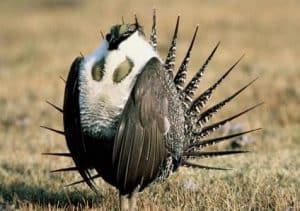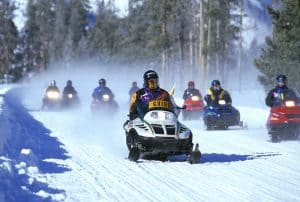Time is running out to comment on the notice that initiated “the scoping process to solicit public comments on greater sage-grouse land management issues that could warrant land management plan amendments” on 15 national forests and grasslands. (Comments are due Friday.) The majority of sage grouse habitat is found on BLM lands (I think the Forest Service has 8%) and the Forest Service is following behind the Department of Interior’s lead to “consider” rolling back restrictions, especially those that interfere with oil and gas drilling. Those restrictions were added to Forest Service and BLM plans in amendments that were adopted in 2015 pursuant to the 1982 planning regulations for species viability, and have been credited with avoiding the need to list sage grouse as threatened or endangered. The Forest Service concedes that amendments it would propose would be likely to be “directly related” to, and therefore subject to, the new diversity and viability requirements of the 2012 Planning Rule. More background from the Forest Service here.
Planning
Shoshone forest plan lawsuit leads to negotiated solution on pack goats
The North American Packgoat Association’s lawsuit reversed a forest plan decision to restrict the use of goats for packing (because of risk of disease spreading to bighorn sheep) based on a procedural violation. They then got together with the National Wild Sheep Foundation and other stakeholders to work out a new plan, which the Shoshone just adopted (presumably as a forest plan amendment, though the Forest website has no information about it).
The balance that was struck prohibits pack goats from territory used by core bighorn sheep herds in the Absaroka Range and Wind River Mountains. It was a concession the goat packers were willing to make, partially because of lack of use and the undesirable nature of the Absaroka as a goat packing destination.
“North of Whiskey Mountain is infested with grizzlies,” Jennings said. “Frankly I didn’t want to go in there anyway.”
Permits will required to bring the pack animals into the Shoshone in areas where they are allowed, which include the entire Washakie Ranger District and the southern reaches of the Wind River Ranger District. The Temple Peak Herd roams the area between the two pack-goat-friendly zones, but the Wyoming Game and Fish Department manage it as a lower-priority herd. The state agency agreed with the Shoshone that the Temple Peak sheep could be subject to a higher level of risk.
The Shoshone’s decision also calls for goat packers to abide by a strict set of rules, like stringing no more than three animals per person, leashing their goats and possessing proof of vaccinations.
Possibly in the background was the result of another lawsuit finding that extirpation of a “lower-priority” herd of bighorn sheep could be a violation of NFMA.
FS preparing for more timber wars?
An interesting observation from an attendee at a meeting on the Medicine Bow National Forest (that may or may not have been “public”):
“During the meeting, the forest service representatives discussed a plan from Washington, D.C., to harvest more trees in national forests…”
Things do get lost in translation from meetings to attendees, to reporters, to print, but does anyone know anything more about this “plan from Washington, D. C.?”
Western Watersheds v. USFS (D. Idaho)
This case involves the decision by the Targhee National Forest to issue new Annual Operating Instructions to the Agricultural Research Service in 2017 to allow the U. S. Sheep Experiment station to continue grazing sheep on two allotments. This case was summarized in today’s Litigation Weekly, but since it found two violations of the forest plan these are worth some further discussion. Note that the case was decided on a motion for a preliminary injunction, and the perceived risk to bighorn sheep viability was key factor in granting the PI to prevent irreparable harm. (There is also a NEPA claim that the court did not decide as part of the PI opinion.)
In order to “provide an opportunity to minimize conflicts between domestic and bighorn sheep,” the Targhee Forest Plan required these allotments to be “phased out on an opportunity basis.” “Opportunity” was defined to include “resource protection.” The court found that new telemetry data showing proximity of the bighorn sheep to the domestic sheep and other new information “reasonably could have been identified as an opportunity” to close the allotments based on the objective of resource protection instead of issuing a new AOI.
The forest plan required the Forest to maintain “at least viable populations of all native and desired nonnative wildlife . . . in habitats distributed throughout their geographic range on National Forest System lands.” The court summarized the Forest Service argument as follows: “the Forest Service asks the court to the measure the Forest Plan’s maintenance requirement not herd-by-herd, but by considering the sum of all of the individual bighorn populations Forest-wide.” The court used a dictionary definition of “maintain” to find that allowing this small herd of bighorn sheep to be extirpated “potentially will diminish the overall population of bighorn sheep throughout the Forest.” “Thus, in no way do the common definitions and understandings support neglect or deterioration of a population of animals (taken as a whole, or in part) that the Forest Service is mandated to maintain.” The court also cited agency requirements for ensuring that sensitive species do not become threatened or endangered (bighorns are classified as sensitive species on the Targhee).
Plan revision on the Rio Grande

They are a little ahead of the Helena-Lewis & Clark discussed on Nov. 29. They are taking comments on their draft plan and EIS. I haven’t read either, but this article provides an overview. Here’s the big picture:
“The purpose and need for revising the forest plan is the changed economic, social, and ecological conditions in the plan area that have occurred since the current forest plan was approved in 1996,” Dallas stated this fall when the draft was released for public review. “These changes include the spruce beetle infestation, closure of mills and timber-related infrastructure in southwest Colorado, changes in communications technology, increased development along the Forest boundary, and the need to shift fire management direction focused on suppression to the use of fire for resource benefit.”
Unlike what we saw on the HLC, this seems to reflect some of the issues that preoccupy this blog (especially the last item recently). Similar to the HLC, there are only two action alternatives, but they are the more traditional left and right of the proposed action (more or less active management).
Alternative B, the draft plan that the Forest is proposing, provides for a balance of multiple uses; Alternative C would increase acreage available for multiple uses and reduce the amount of management areas; and Alternative D would propose less active management of resources and increase semi-primitive, non-motorized opportunities.
I think the planning process can work with a small number of alternatives if they are well-designed to address the relevant issues and impacts and if, as the Rio Grande says here, the parts can be mixed and matched to produce a final preferred alternative that is within the range of what was in the DEIS. Here’s the Forest’s explanation of what their plan does:
Blakeman said the draft plan is broken down into: overarching goals that provide “big picture” guidance such as protecting water resources and terrestrial ecosystems and contributing to economic sustainability; desired conditions representing the vision of what the Forest should look like in the future; concise, measurable objectives, which guide the process and timeline to attain the desired conditions; and standards, guidelines and management approaches that provide constraints and/or site-specific direction. Blakeman said standards and guidelines are harder to change once in place but management approaches can be changed to adapt to changing conditions on the ground.
“Management approaches” are a possible red flag. I’ve seen them used where the standards and guidelines are needed. If the Forest can change or ignore management approaches, this has to be recognized in the effects analysis. And they shouldn’t count towards meeting requirements for plan components (like diversity) because they are not plan components.
One other pet peeve. Why can’t they use map colors that mean something, like mirroring the active/passive management scheme?
What people want from the Helena-Lewis and Clark National Forest plan
There’s a summary of the scoping comments available on the Forest’s planning website. “The number of comments for or against forest uses or management were not tabulated as ‘votes,'” but here’s the top 3:
“The most common topic was the concept of recommended wilderness or designated
wilderness. Roughly 46% of the comments offered input related to these designations,
including desires for more, less, specific area or boundary suggestions, and input as to
what uses should be allowed in such areas.”“Many comments included input related to motorized uses, nonmotorized uses, trails,
roads, access, and other travel planning issues on the Forest. Comments related to these
topics represent about 28% of all comments received…”“Comments about wildlife and habitat frequently overlapped with comments about motorized use, recommended wilderness, and other resource management issues. Comments that included input on these topics represented roughly 21% of the total comments received.”
Other categories of likely interest: Water – 10%, and fire/fuels, climate change and vegetation management each at – 7%. (The %s add to more than 100, so these must represent the % of comment letters that addressed each topic.)
Despite not counting votes, it looks like they aren’t considering any alternatives related to wildlife, vegetation or fire except as a timber harvest and production problem. I’m not seeing anything ecological here, making me think they just want to meet the legal minimum for diversity. It reminds me of the current Helena plan I helped write 35 years ago (but I don’t think that’s a good thing). Hopefully there’s more here than it appears.
Who gets to be “in the room”
Discussion about the unfair access of litigants to decision-makers ignores the privileged position of local governments and economic interests during the planning process. That is illustrated by this account of a meeting between the Forest Service, ESA regulatory agencies and northeast Oregon ranchers and county commissioners concerning revision of the Blue Mountains forest plans and changes in grazing requirements. It sounded good up through the point where a forest supervisor said, “It was a productive meeting. People said we need to do this more often — get around the table and share our thoughts in a respectful way.”
But here’s what the local public is taking home from the meeting (I’ve added the italics):
One of the major bones of contention with the plan among ranchers was something referred to as Watershed Condition Framework, which would require ranchers to leave taller grass stubble after grazing. “We got buy-in from the Forest Service that Watershed Condition Framework is out the door,” Nash said. (WCF is actually a national requirement.)
Matt McElligott of North Powder was asked to attend the meeting as a representative of the cattle industry. He said the county commissioners and the ranchers asked that the Forest Service use grazing guidelines and not standards. The commissioners also asked that those guidelines be assessed allotment by allotment rather than across the more than 5 million acres on the three forests. “When we left the meeting the other day, we got close to all the points the commissioners wanted,” McElligott said.
Those in attendance methodically went over each point step by step, hashed out the terminology and agreed to the items proposed for inclusion in the Pacific Northwest Regional Forester’s Record of Decision due early next year, McElligott said.
This seems to me to create a lose-lose situation. Either the attendees get what they want and the Forest Service and regulatory agencies look like they are making backroom deals, or they don’t and they feel betrayed (and might sue). A reason why such “collaboration” is not a substitute for public involvement and NEPA – or for litigation.
WA murrelet strategy should “meet only minimum federal standards for protections”
At least that’s what the Washington state politicians are urging their Department of Natural Resources to adopt for its lands.
The DNR is currently considering five different proposals to protect the bird species. A final decision is expected within the next few weeks. Walsh has come out in favor of “alternative B” which he says would meet minimum federal standards for species preservation while ensuring the least amount of negative impact on local economies.
A press release noted that Walsh, and his peers who signed off on the letter to the DNR, believe that reduced timber sales in coastal communities would “create significant economic hardship on counties and communities that can least afford it.”
In other words, let’s manage this species so it stays on the edge of extinction. This is why we have endangered species (and a federal Endangered Species Act).
Case on forest plan wilderness recommendations
Ten Lakes Snowmobile Club v. U. S. Forest Service
(Mentioned by Brian Hawthorne here, with links to an article and the opinion.)
This case was about the decision in the 2015 revised Kootenai and Idaho Panhandle National Forest plans to recommend (to Congress) areas for wilderness and to manage them to protect their wilderness values. The Montana district court upheld the forests’ wilderness evaluation methodology, and their decision that effects on several wildlife species warranted prohibition of motorized and mechanized activities in the recommended wilderness areas (RWAs). It also reiterated precedents that the Forest Service may choose to manage non-wilderness areas similar to designated wilderness. It found that the EISs included proper no-action alternatives, and that the Kootenai properly coordinated with the Glen Lake Irrigation District (and did not have to be consistent with their “Natural Resource Plan.”)
Existing policy is that areas recommended for wilderness designation will be managed to prohibit activities that would “reduce the wilderness potential” or “compromise the wilderness values” of the area. At issue is the role that Forest Service Region 1 policy played in the decision to exclude over-snow vehicles and mechanized use from these areas; specifically whether it improperly influenced the required site-specific analysis for each area. Plaintiffs argued that the policy “created an inflexible prohibition of all motorized and mechanized travel in the RWAs.” The court found this argument to be “unfounded and purely speculative,” and, “The record demonstrates that the FEIS in the Kootenai and Panhandle Forests considered site-specific impacts of motorized and mechanized vehicles.”
Plaintiffs also challenged decisions to manage areas as recommended wild and scenic rivers. The court found that the Forest Service violated NEPA by including two creeks that had not been considered in any alternatives in the planning process prior to the final Record of Decision, which was after the public objection process. It remanded the Kootenai plan for the narrowly defined purpose of providing an objection period for that decision for these areas. It did not require a supplemental EIS because the area involved was 0.1% of the national forest which constituted “a minor variation that was qualitatively within the spectrum of alternatives that were discussed in the FEIS.” It did agree with the Forest Service that the creeks meet the requirements of the Wild and Scenic Rivers Act to be considered eligible.
Another September case
Wild Wilderness v. Allen seems to have not shown up on the Forest Service litigation reports, but here is a newspaper version. On Sept. 8, the Ninth Circuit found that the decision to build the Kapka Sno-Park, a parking lot for snowmobile users on the Deschutes National Forest, was consistent with the forest plan and did not require an EIS. I found a couple of points interesting.
One was the court’s treatment of forest plan “standards and guidelines” that were prefaced with language indicating discretion. The court said, “But nothing in this provision mandates closure of any area to motorized use. It merely outlines steps that “will generally be taken” in the event of user conflicts. The Forest Plan outlines “an aspiration, not an obligation” and therefore “there is no law for us to apply in second-guessing the agency.”” It similarly dismissed language from the Recreation Opportunity Spectrum as “nonbinding guidance.” Note to the public participating in forest planning – if the plan doesn’t say “must” or “shall” the Forest Service won’t have to. (Recreation, unlike wildlife, doesn’t have any substantive requirements that a plan must meet using mandatory language.)
On the NEPA side, the court held that the forest didn’t have to explain why it changed from an EIS to an EA, as long as it justified the EA. It rejected the comparison “to cases in which agencies failed to provide reasoned explanations for changes in their position on matters of policy or factual findings.” The court stated, “The Forest Service here, however, never changed its mind on any factual or policy matter but only on how it planned to comply with its own procedural requirements. There was no agency decision to reverse, as a draft EIS is not an agency decision at all.” An EIS is not a decision, but this holding only makes sense to me if an EIS also does not represent a finding that there are significant impacts, which is would be a “factual finding.” In fact, an EIS may be prepared by an agency even if effects are not significant, so changing from an EIS to an EA doesn’t necessarily trigger an additional burden of explanation for the agency.


